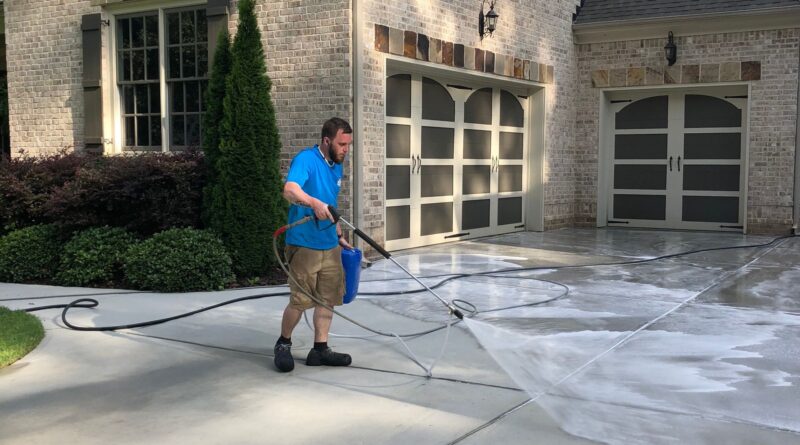Mastering Patio Maintenance: Power Wash Solutions for Every Type of Surface
Maintaining a patio is crucial for extending its lifespan, enhancing its appearance, and ensuring it remains a safe, enjoyable space for outdoor activities. Over time, patios can accumulate dirt, grime, algae, and other elements that can tarnish their beauty and lead to surface deterioration. Power washing, a powerful cleaning method that utilizes high-pressure water to remove stubborn dirt and stains, is an effective solution for keeping patio surfaces in top condition.
Patio Maintenance and Power Washing
Power washing not only revives the look of your patio but also prevents the growth of mold and mildew, which can cause health issues and surface damage. However, mastering patio maintenance through power washing requires an understanding of different materials and the specific care they need. Each patio type, whether concrete, brick, wood, or natural stone, has unique characteristics that dictate the best cleaning practices. Using the wrong pressure setting or cleaning solution can damage the surface, leading to costly repairs.
This guide aims to provide homeowners with expert tips and strategies for power washing various patio surfaces. By acknowledging the distinct needs of each material, you can ensure a thorough clean without compromising the integrity of your patio. From preparing the area to selecting the right equipment and aftercare, we’ll cover everything you need to know to master patio maintenance and enjoy a pristine outdoor living space for years to come.
Evaluating Your Patio’s Material
Before you embark on the power washing journey, it’s crucial to evaluate the material of your patio accurately. This initial step is vital because the type of material not only influences the cleaning method you’ll use but also determines the pressure settings, detergents, and techniques that are safe and effective for your specific patio. Here’s how to properly assess the material of your patio and understand its maintenance needs:
Identify the Material: Patios can be constructed from a variety of materials, each with its own set of characteristics. Common materials include concrete, brick, pavers, wood, composite decking, and natural stone (such as slate, limestone, or bluestone). If you’re unsure of your patio’s material, you might need to do a bit of research or consult with a professional.
Consider the Material’s Characteristics: Each patio material has unique properties that affect how it should be cleaned:
Concrete is durable and can usually withstand higher pressure, but it is porous and can hold stains.
Brick and Pavers offer a classic look but can be prone to chipping or displacement if not handled gently.
Wood decks require careful cleaning to avoid damage to the wood fibers and to prevent the surface from becoming too slippery.
Natural Stone varies widely in porosity and softness, with some stones being more susceptible to damage from high pressure or harsh chemicals.
Inspect for Damage: Look for any existing damage, such as cracks, chips, or signs of erosion. The presence of damage may affect how you approach power washing, as you’ll want to avoid exacerbating these issues.
Understand Maintenance History: Knowing any treatments or sealants that have been previously applied to your patio can inform your cleaning approach. Some chemicals can strip sealants or damage the finish on certain materials, so it’s essential to choose your cleaning solutions accordingly.
Properly evaluating your patio’s material and condition sets the stage for effective maintenance. By understanding the specific needs and vulnerabilities of your patio’s surface, you can select the most appropriate power washing techniques and products, ensuring a clean, revitalized outdoor space without causing harm.
Preparation for Power Washing: Essential Steps
Proper preparation is key to a successful and efficient power washing session for your patio. By following these essential steps, you can ensure safety, protect your property, and achieve the best cleaning results:
Safety Gear: Begin by equipping yourself with the necessary safety gear. This includes wearing protective eyewear to shield your eyes from debris, waterproof gloves to protect your hands from harsh cleaning chemicals, and sturdy, non-slip shoes to prevent slips and falls.
Clear the Area: Remove all furniture, grills, planters, and decorations from the patio. This not only protects your items from damage but also gives you unobstructed access to the entire surface for thorough cleaning.
Sweep and Rinse: Use a broom to sweep away loose dirt, leaves, and debris from the patio. A preliminary rinse with a garden hose can help loosen and remove surface dirt, making the power washing process more effective.
Choose the Right Equipment: Select a power washer with the appropriate pressure settings for your patio material. A washer with adjustable pressure is ideal, as different surfaces require different levels of pressure to clean effectively without causing damage.
Select the Proper Nozzle: The nozzle you choose will determine the water spray’s intensity and spread. A wider angle nozzle (e.g., 40 degrees) is suitable for delicate surfaces, while a narrower angle (e.g., 15 degrees) can be used for more durable materials like concrete.
Prepare Cleaning Solutions: If you plan to use cleaning solutions or detergents, ensure they are suitable for your patio’s material and the type of stains you’re addressing. Mix or dilute solutions according to the manufacturer’s instructions.
Protect Surrounding Areas: Cover plants, grass, and nearby landscaping features with tarps or plastic sheeting to protect them from runoff, especially if using chemical cleaners. Also, consider the direction of water flow to avoid causing water damage to other areas.
Check Weather Conditions: Ideal power washing conditions are on a cloudy day or when the patio is in the shade. This prevents the sun from drying the cleaning solutions too quickly, which can result in uneven cleaning and visible streaks.
Familiarize Yourself with the Power Washer: If it’s your first time using the equipment, take a moment to familiarize yourself with its operation, safety features, and how to adjust the pressure settings and change nozzles.
By meticulously preparing for power washing, you set the stage for a cleaning process that is not only effective but also safe for your patio, your property, and yourself. Taking these steps ensures that you can tackle the task with confidence and achieve a beautifully clean patio ready for enjoyment.
Power Washing Concrete Surfaces: Techniques and Tips
Power washing concrete surfaces requires a careful approach to effectively remove dirt, stains, and mildew without damaging the surface. Concrete is a durable material, but improper techniques can lead to surface damage, such as etching or pitting. Here are key techniques and tips for power washing concrete patios or driveways:
Select the Appropriate Pressure: Concrete can generally withstand high pressure, but it’s important to start at a lower setting and gradually increase as needed. A pressure of 3000 PSI is typically effective for cleaning concrete surfaces without causing damage.
Choose the Right Nozzle: A 15 to 25-degree nozzle provides a balance between cleaning efficiency and surface safety. It’s wide enough to cover a decent area while providing enough force to clean effectively.
Pre-treat Stains: For tough stains like oil or grease, pre-treat the area with a degreaser or a concrete cleaner. Apply the cleaner according to the manufacturer’s instructions and allow it to sit for several minutes to break down the stains before power washing.
Test in a Small Area: Before starting the full cleaning, test the power washer on a small, inconspicuous area of your concrete surface. This helps ensure the pressure and nozzle choice do not damage the concrete.
Use a Sweeping Motion: When power washing, move the wand in a steady, sweeping motion. Overlap each pass slightly to ensure even cleaning and prevent streaking. Keep the nozzle about 12 to 18 inches from the surface for optimal cleaning.
Maintain a Consistent Distance: Holding the nozzle at a consistent distance from the concrete helps avoid uneven cleaning and pressure marks. Adjust your stance and the angle of the wand as necessary to clean effectively.
Rinse Thoroughly: After removing dirt and stains, thoroughly rinse the concrete with clean water to remove any residual cleaner. This step is crucial to prevent any chemical buildup that could damage the surface over time.
By following these techniques and tips, you can effectively power wash your concrete surfaces, restoring their appearance and extending their lifespan. Always prioritize safety by wearing appropriate protective gear and following the power washer’s operating instructions.
Aftercare Strategies: Extending the Life of Your Power Washed Patio
After power washing your patio, implementing effective aftercare strategies is crucial to maintain its appearance and extend its lifespan. Proper aftercare not only enhances the beauty of your outdoor space but also protects your investment. Here are key strategies to consider:
Allow the Patio to Dry Completely: Before returning furniture or walking on the surface, it’s essential to let the patio dry thoroughly. This is especially important if you’re planning to apply a sealer, as moisture trapped beneath the sealer can lead to issues like peeling or cloudiness.
Apply a Protective Sealer: For concrete, brick, pavers, and natural stone patios, applying a sealer can offer protection against stains, UV damage, and water penetration. Select a sealer appropriate for your patio material and environmental conditions. Follow the manufacturer’s instructions for application, ensuring an even coat for optimal protection.
Re-Sand Paver Joints: If your patio consists of pavers, the power washing process may have dislodged some of the joint sand. Replenishing this sand is important for maintaining the structural integrity of the patio. Use a broom to sweep polymeric sand into the joints, then lightly mist with water to activate the binding agent.
Routine Cleaning: Incorporate regular cleaning into your maintenance routine to prevent the buildup of dirt, leaves, and other debris that can stain or damage the patio surface. Simple methods like sweeping and rinsing with a garden hose can be effective for keeping the patio clean between deep cleanings.
Immediate Stain Treatment: Address spills and stains promptly to prevent them from setting into the patio material. Use appropriate cleaners for your patio type, and always test cleaning products on a small, inconspicuous area first to ensure they won’t cause discoloration or damage.
Furniture and Plant Protection: Use protective pads under patio furniture to prevent scratches and rust stains on the surface. Consider placing potted plants on stands or saucers to avoid water stains and facilitate better drainage.
By following these aftercare strategies, you can enjoy a beautiful and durable patio for many years to come. Regular maintenance and protective measures are key to maximizing the benefits of your power washing efforts and ensuring your outdoor space remains a welcoming extension of your home.

